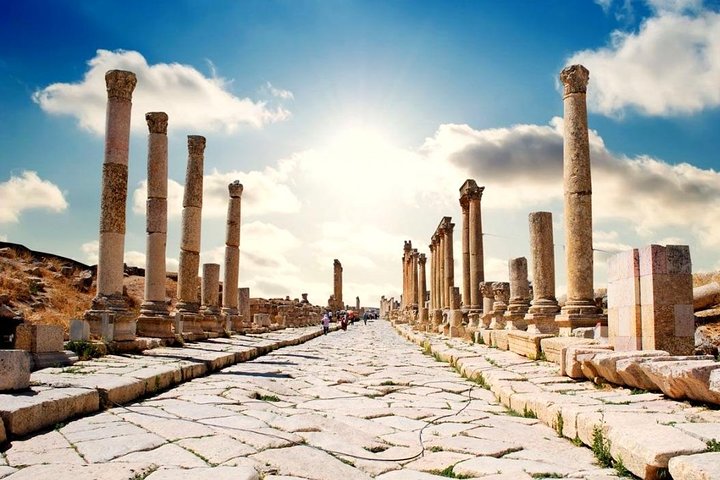Exploring the Timeless Treasures of Northern Jordan
Eager to explore the historical wonders of northern Jordan, I embarked on a journey to Umm Qais, Ajloun, and Pella. Each site offered a unique glimpse into the past, from the basalt structures of Umm Qais to the resilient fortress of Ajloun, and the cautionary tale of Pella.
Discovering the Ancient Wonders of Umm Qais
Our journey began with a drive through the lush, rolling hills of northern Jordan, a landscape that seemed to whisper stories of ancient civilizations. As we approached Umm Qais, the anticipation in our car was palpable. Known for its proximity to the ruins of Gadara, Umm Qais is a site that promises a unique blend of history and natural beauty. Upon arrival, I was immediately struck by the use of basalt stones in the construction of the ancient structures, a stark contrast to the white marble and reddish sandstone typically seen in Jordan. This unique feature set the tone for a day of exploration and discovery.
The site, though largely destroyed by earthquakes and time, still holds a certain majesty. Walking through the ruins, I felt a deep connection to the past, imagining the lives of those who once walked these paths. The road leading to the Sea of Galilee, still largely intact, beckoned us to explore further. I learned that one could embark on a two-day hiking trip down this ancient road, a tempting adventure for another visit. Despite the site’s condition, I found myself lingering longer than planned, captivated by the stories etched into the stones.
The Resilient Fortress of Ajloun
Our next stop was Ajloun Castle, a 12th-century fortress perched atop a hill, offering panoramic views of the surrounding countryside. The castle, originally a monastery, was transformed into a formidable Arab fortress, and its strategic importance is evident in its robust architecture. As we explored the ramparts, I was impressed by the castle’s excellent condition, a testament to the care taken to preserve this historical gem.
Despite some areas being under repair, the majority of the castle was accessible, allowing us to wander through its storied halls and imagine the lives of those who defended its walls. The presence of local visitors added a vibrant energy to the site, a reminder of the castle’s continued significance in the region. Ajloun Castle is not just a relic of the past; it is a living part of Jordan’s cultural heritage, and its resilience is a source of inspiration.
A Cautionary Tale at Pella
Our final destination was Pella, a site that, unfortunately, did not live up to the grandeur of its past. Once a thriving city-state, Pella now stands in stark contrast to the well-preserved sites we had visited earlier. The neglect was evident, with graffiti marring the ancient stones and garbage littering the grounds. The rusted signage and peeling paint told a story of a site in need of care and attention.
Despite its current state, Pella holds potential. The remnants of its past glory are still visible, and with proper preservation efforts, it could once again become a site of historical significance. As a museum curator, I couldn’t help but think of the possibilities for interactive exhibits and educational programs that could bring Pella’s history to life for visitors of all ages. It was a sobering reminder of the importance of preserving our cultural heritage for future generations.
In conclusion, our tour of northern Jordan was a journey through time, offering a glimpse into the rich tapestry of history that defines this region. From the unique basalt structures of Umm Qais to the resilient fortress of Ajloun, and the cautionary tale of Pella, each site offered its own lessons and stories. For families seeking an educational and engaging travel experience, northern Jordan is a destination that promises both adventure and insight.




















































